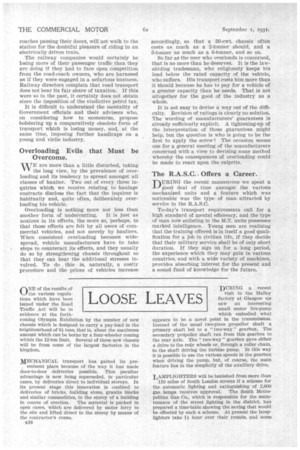O NE of the results of the various regulations which have
Page 36

Page 37

If you've noticed an error in this article please click here to report it so we can fix it.
been Issued under the Road Traffic Act will be in evidence at the forthcoming Olympia Exhibition by the number of new chassis which is designed to carry a pay-load in the neighbourhood of 6+ tons, that is, about the maximum amount which can be borne by a four-wheeler coming within the 12-ton limit. Several of these new chassis will be from some of the largest factories in the kingdom.
MECHANICAL transport has gained its preeminent place because of the way it has made door-to-door deliveries possible. This peculiar advantage is now being superseded, in particular cases, by deliveries direct to individual storeys. In its present stage this innovation is confined to deliveries of bricks, building stone, granite blocks and similar commodities, to the storey of a building in course of erection. The material is packed in open cases, which are delivered by motor lorry to the site and lifted direct to the storey by means of the contractors crane.
1318 DURING a recent
visit to• the Halley factory at Glasgow we saw an interesting. small motor fire-pump which embodied what appears to be a novel point in the transmission. Instead of the usual two-piece propeller shaft a primary shaft led to a " two-way " gearbox. The secondary propeller shaft ran from this gearbox to the rear axle. The " two-way " gearbox gave either a drive to the rear wheels or, through a roller chain, to the shaft driving the turbine pump. In this way it is possible to use the various speeds in the gearbox when driving the pump, but, of course, the main feature lies in the simplicity of the auxiliary drive.
LAMPLIGHTERS will be banished from more than 110 miles of South London streets if a scheme for the automatic lighting and extinguishing of 2,600 gas lamps receives approval. The South Metropolitan Gas Co., which is responsible for the maintenance of the street lighting in the district, has prepared a time-table showing the saving that would be effected by such a scheme. At present the lamplighters take 11 hour over their rounds, and some lamps are, therefore, lighted much earlier than need be.
The lamplighters will still be required for cleaning and maintenance work, as well as for the more expert tasks of setting, adjusting and winding the control clocks.
pOSSIBLI the longest journey that has ever been undertaken by a taxicab was recently made, when a Scottish banker chartered a vehicle in London for a trip to the Isle of Skye, a distance of about 600 miles. The taxicab was used for three weeks, in the north of Scotland, and a total mileage of 2,160 was covered. The vehicle in question was nearly a year old and had travelled 20,000 miles.
NOT the least important of those interested in the ultimate effect of the London Passenger Transport Board are the residents in outlying towns who travel regularly to and from London on six days a week and who, for the past year or two, have used the motor-coach services. The personal element introduced by the private operators, not to mention the comfort of their vehicles, affords such a welcome contrast to the smoky and uninviting steam trains, with their drab stations and unconcerned porters, that any thought of returning to the rail is intolerable, and the fear of monopoly control of the coaches is disturbing enough. It will be a pity if the pleasant relationship now existing between owner-drivers and patrons is to be lost.
THE main entrance to the new home of London Coastal Coaches, in _Buckingham Palace Road, London, is faced with a mixture of broken beerbottle glass and white cement. The glass was first crushed and mixed with the cement and the mixture then poured between the shuttering. When the cement had set the boards were removed and the surface rubbed down. By this means the small pieces of glass were exposed on the surface, giving to it a scintillating effect.
This new form of finish has great possibilities, for one is not restricted as to colour. By using poisonbottle glass, for example, a blue concrete is obtained, whilst other colours can be used to give a pleasing ornamental touch.




































































































